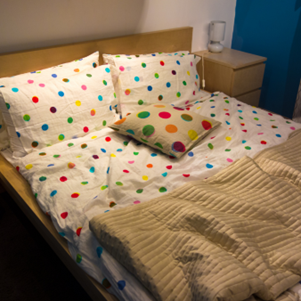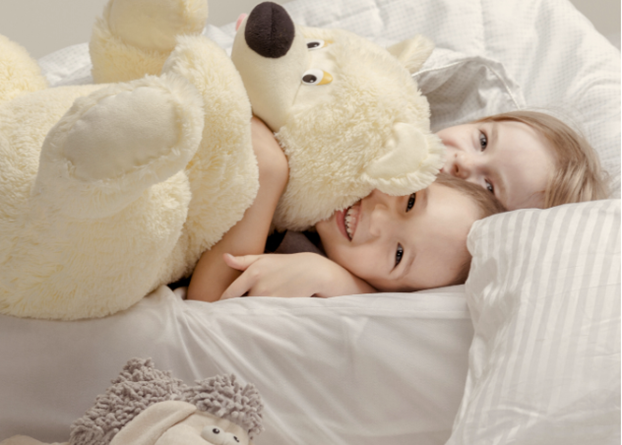Eternal Hope Therapeutics Blog

3 September 2024
If you’re a parent of young children, you’ve likely encountered many nights with too little sleep. For parents and caregivers of children with Autism Spectrum Disorder (ASD), sleep challenges can be debilitating. General estimates indicate that up to 80% of children diagnosed with ASD have sleep difficulties. Here are 6 proven strategies to promote positive sleep behaviors: 1. Bedtime should be calm, quiet, and relaxing. The lights in the room should be dim, and no screen time should occur in the bedroom. White noise may help to drown out other sensory-related issues.

3 September 2024
Children of all backgrounds can have a feeding disorder, but there is a higher rate of feeding issues in children with developmental disabilities (40-80%). Groups of children who are more likely to be diagnosed with a feeding disorder include premature infants, children with Failure to Thrive, children with autism, and children with various genetic syndromes. While the exact causes of feeding concerns are not fully understood, there are several factors that may contribute to these challenges. We offer three distinct profiles of feeding challenges for parents and caregivers to consider.

1 January 2024
Introduction If you’re a parent of young children, you’ve likely encountered many nights with little sleep. For parents and caregivers with children with Autism Spectrum Disorder (ASD), sleep challenges can be debilitating. General estimates indicate that up to 80% of children diagnosed with ASD have sleep difficulties (Chen et al., 2021). Sleep problems are usually seen as a skill deficit that can be addressed by teaching relevant skills. Many parents of children with ASD don’t even understand that this is a deficit because they think “it’s just Autism,” but it’s not. All kids with ASD can learn to sleep through the night. What is “Good Sleep?” Biologically, we wake up an average of eight times per night, but the goal is not to remember waking up. Good sleep traits include staying asleep all night, waking up refreshed, getting a particular amount of rest, falling asleep quickly, rising without much trouble each morning, and not feeling drowsy during the day. Healthy sleepers take 2-3 minutes to fall asleep when their head hits the pillow. The goal should be 15 minutes or less. If you’re not sleeping, your body is engaged in some activity (checking your cell phone, tossing and turning, ruminating), etc. Without good sleep, people with ASD may be more likely to engage in challenging behaviors. When children don’t sleep, they’re more likely to be obese; they may have anxiety in adulthood and increased behavioral and emotional problems. Many pediatricians tell parents their child will “grow out of it,” which is invalid. There is a higher divorce rate for families with children with ASD, which may be caused by lack of sleep, co-sleeping, etc. Historically, we were built to sleep together. A cave in Africa that was 50,000 years old showed that people slept together. We were created to sleep when it’s dark and cool and when there were no reinforcers other than sleep. Now, there are multiple reinforcers available 24/7. Our culture is very different now. Parents often look to their pediatrician (not behavior analysts) for advice on sleep. However, pediatricians typically only get 5 hours of training on sleep, 4 hours of which are in anatomy. Most of the treatment options pediatricians recommend have been a sleep aid prescription. However, all sleep medications are “off-label” (not primarily designed to address issues with sleep). Almost every child with an Autism diagnosis who struggles with sleep is taking a sleeping medication. These drugs help decrease the time it takes to fall asleep, but when the medications wear off, the problem remains. If a child is on medication, they cannot be adequately taught how to fall asleep on their own effectively. Reasons Why Children May Have Trouble Sleeping Sleep disorders occur for many reasons, and they can manifest in many ways, including: delayed sleep onset minimal sleep duration frequent waking rigid sleep behaviors, and medical issues. Children with Autism may struggle with sleep for a variety of reasons, including: Environmental Stimuli: Many children with Autism have difficulty processing sensory information, making it challenging to fall asleep. They may be hypersensitive to stimuli such as noise, light, or touch or seek out sensory input to help them feel calm. Anxiety and Stress: Children with Autism may struggle with anxiety or have difficulty regulating their emotions, which can interfere with their ability to fall asleep and stay asleep. They may also have difficulty understanding and coping with changes in routine or unexpected events, which can cause stress and disrupt their sleep patterns. Medical Considerations: Children with Autism may have other conditions, such as epilepsy, gastrointestinal issues, or ADHD, which can interfere with their sleep. In addition, medications used to treat these conditions may also affect sleep patterns. Sleep Disorders: Children with Autism may also be at higher risk for sleep disorders, such as sleep apnea, restless leg syndrome, or periodic limb movement disorder. These conditions can interfere with the quality of their sleep and make it harder for them to feel rested. How Can ABA Help with Sleep Issues? The first step of the assessment process requires the BCBA to collect information from the child’s caregivers regarding the child's nighttime routine and sleep habits. Typically, this involves completing an interview, collecting sleep behavior data, and conducting an observation. If the BCBA can’t attend the observation during the child’s nighttime routine, caregivers may consider collecting video clips to share for analysis. If the child has frequent snoring, coughing, or gagging episodes during sleep, it’s recommended that the family seek medical consultation to rule out any underlying medical issues such as sleep apnea, enlarged tonsils/adenoids, or any other condition that may impact the quality and quantity of sleep. Further, if the child takes any type of medication, a physician may rule out side effects of the drug (s) that impact sleep. Once medical conditions have been ruled out, the BCBA may begin assessing and treating the sleep disorder. Throughout the assessment process, the caregiver will be asked to keep sleep logs for 1-2 weeks, which record (1) the initial time the child went to bed, (2) the number of times they woke up, (3) what time(s) they woke up, and (4) if they moved to another location such as the caregiver’s bed. Depending on the factors that influence the child’s sleep patterns, the following considerations may be helpful to families. Problem 1: Delayed Sleep Onset This variable includes extended durations of time until the child falls asleep. They may go to bed on time but lay there for hours before falling asleep. This may also include getting in and out of bed frequently and requesting water/food/attention while they’re waiting to fall asleep. Suggestion: Use bedtime fading procedures, such as starting the sleep routine later in the evening when the child is likely to fall asleep. If your child typically falls asleep at 9:45 PM, begin the sleep fading at 9:30 PM. Once the child consistently falls asleep at 9:30 PM, return to 9:00 PM. Make sure that these sleep time changes occur in small increments of time. The general recommendation is that when the child falls asleep within 20 minutes of laying in their bed for 3-5 days, move the bedtime routine back by 15 minutes until bedtime occurs at a reasonable time. Problem 2: Frequent Waking These events occur after the child has fallen asleep for brief periods. They may go to sleep at 8:00 PM but wake up at 11:00 PM and 2:00 AM; the problem isn’t falling asleep. It’s staying asleep. Suggestion: Caregivers may consider using positive reinforcement procedures to reinforce the behavior of staying in bed instead of getting up. Think of ways to make staying IN bed more reinforcing than being OUT of bed. Examples include purchasing a body pillow or full bed tent, allowing sleep to occur with soothing music that plays all night on a Bluetooth speaker, glow-in-the-dark stars on the room's ceiling, and establishing a consistent sleep schedule. Another suggestion is to set a time threshold before you attend to the child and then increase this time interval gradually. This is called a shaping procedure, where you’re shaping the amount of time the child learns to be alone and can start to engage in behaviors that promote sleep instead of depending on the caregiver to satisfy those needs. Problem 3: Rigid Sleep Behaviors These rigid behavior patterns include children setting “rules” about when, where, and under what conditions sleeping occurs. Some examples include a child requiring a parent to lie with them, sleeping on specific couches, sleeping with a particular toy or blanket, etc. Without these self-defined rules, the child can’t sleep. Suggestion: A shaping process may also be successful in addressing rigid sleeping patterns. Caregivers can agree to stay with the child for longer durations (until they fall asleep) and then slowly decrease the duration they spend with the child. If the child requires the caregiver’s presence, the caregiver can use an air mattress to lay on the floor next to the child for two days, then move the air mattress closer and closer to the door until they’re entirely faded from the child’s room. The caregiver may also wish to replace their presence with a “comfort” item such as a soft full-body pillow, a giant stuffed animal, a piece of their clothing that the child can hold, etc. Problem 4: Sleeping in Caregiver’s Bed This happens when the child refuses to sleep in their bed or will return to the caregiver’s bed throughout the night. Suggestion: While it’s easy to allow these behaviors to occur out of exhaustion, remember that what you reinforce today, you will get tomorrow! Each family has their comfort level with co-sleeping with children, and once you decide on the rules for this, let the child know what you expect. It’s essential to always provide positive reinforcement to the child for sleeping in their bed. Other behaviors to reinforce include calling out to the parent instead of entering their bed. If you don’t want the child to be in your bed at all, when the child enters the bed, calmly return them to their bed and issue a neutral statement such as “This is where you sleep.” Caregivers must remain calm and neutral during this process. Don’t give the child excessive attention, such as getting a drink of water, reading a book, lying with them for the rest of the night, or other forms of reinforcement. This response will teach the child that staying in their bed receives MORE reinforcement than going into the caregiver’s bed. Instead, reinforce staying in their bed and provide a reward in the morning if they remain in their bed. Depending on their age and ability to delay gratification, you should eventually fade out the use of daily rewards so that they need a week of staying in bed to earn a reward. Top 6 Strategies for Addressing Sleep Issues in Children with Autism Now that we’ve discussed the suggested recommendations for specific sleep behaviors, we will review some general guidelines promoting positive sleep hygiene. These six strategies should be used concurrently with the suggestions listed above. Strategy #1: Develop an ideal sleep schedule. Be aware of the age-appropriate sleep needs of your child. Younger children need more sleep than older ones. You should also recognize the importance of current sleep phases and the “forbidden zones.” Children will likely be awake and alert about 3 hours earlier than regular bedtimes. They will want to go to bed later and wake up later. We recommend starting the sleep routine slightly later than when the child fell asleep the previous night. If they begin to fall asleep within 15 minutes, then move the bedtime to 15 minutes earlier the next night, repeating until the desired bedtime is achieved. Dr. Greg Hanley calls this approach “faded bedtime,” which usually takes about a week. Be prepared; this may mean a later wake-up time the next day. If your child is school-aged and has an IEP, advocate for this schedule adjustment. For example, you may ask your child’s teacher for one week of allowance to attend school later. Strategy #2: Optimize bedroom conditions. Try some of these tips to help make your child’s bedroom an optimal environment to encourage sleep: Set the bedroom environment to be dark. The lights in the room should be dim, and no screen time should occur in the bedroom. Create a cool climate. Consider how much clothing the child wears and the weight of the blankets on the bed. Some children enjoy weighted blankets. However, if they get overheated, this may impact the quality of their sleep. Remove background noises from the bedroom. If a silent environment isn’t possible, use a sound machine with “white noise” that does not change in pitch, tone, and frequency. This blocks out the other sounds from your home. We will adapt to the neutral sound and relax, but this can’t happen with music. Strategy #3: Limit drinks, snacks, and rigorous activities 1-2 hours before bed. Consider quiet activities, such as listening to soothing music or an audiobook through a Bluetooth speaker, taking a bath, or reading a book to your child. Strategy #4: Develop a consistent bedtime routine you follow every night. Create comforting rituals embedded into a routine, such as stories and lullabies, for a positive experience and cherished memories. Children with ASD thrive in highly structured environments. Consider adding visuals, such as a visual schedule that depicts the events of the evening before bedtime. Say “I love you” to your child each night and give them something to look forward to for a sleep routine. Strategy #5: Address sleep-interfering behaviors Children who struggle to follow instructions during the day will likely find it difficult to get into bed at night. ABA techniques, such as positive reinforcement, can encourage the child to engage in desired sleep behaviors. For example, the child might earn rewards for going to bed simultaneously every night or avoiding electronic devices before bedtime. If the child refuses to comply with bedtime expectations, you should continue with his/her nighttime routine (books, parent laying with child), etc., but only provide a small amount. If they are compliant, offer higher quality and more time with the nighttime ritual. Strategy #6: Consider a “visual alarm clock”. These devices guide children with visual cues to tell them when to stay in bed and get up. An example can be found here: VISUAL ALARM CLOCK . Conclusion In summary, a BCBA can use the scientific principles of Applied Behavior Analysis to teach families how to promote sleep hygiene. This is accomplished by isolating the variables that impact the behavior into specific components and then targeting each of these components with interventions. With a collaborative approach, the BCBA can work with other child medical team members to develop a tailored treatment plan.
LOCATIONS
Asheboro Office
616 Albemarle Rd.
Asheboro, NC 27203
Thomasville Office
234 Cedar Lodge Rd.
Thomasville, NC 27360
HOURS
Monday - Friday
8:00am - 5:00pm
Saturday and Sunday
Closed










Content, including images, displayed on this website is protected by copyright laws. Downloading, republication, retransmission or reproduction of content on this website is strictly prohibited. Terms of Use
| Privacy Policy
Content, including images, displayed on this website is protected by copyright laws. Downloading, republication, retransmission or reproduction of content on this website is strictly prohibited. Terms of Use
| Privacy Policy

